This week, controversy blew up when Konstantin Kisin debated with the Spectator’s notoriously liberal Fraser Nelson whether Rishi Sunak is English. For Kisin, Sunak – like himself – was British, but his ancestry and cultural markers precluded him from being English. This debate reminds me of the film Groundhog Day: it pops up with depressing regularity, but never seems to get anywhere.
Is Sunak English? As someone who has written on, researched and taught ethnicity and national identity for 30 years, I think I can speak authoritatively on this.
As I posted on X (yes, mea culpa, I reposted myself!), the matter seems quite simple. Sunak is English by nationality, as well as a British national.
However, he is not a member of the English ethnic majority within England, nor is he part of the 80% white British pan-ethnic majority of the United Kingdom.
In these debates, it’s vital to begin with some basic terms. Type concepts, like elements in a periodic table, measure something real in the world, a clustering of statistically unlikely values of variables. Instead of valence and atomic weight for the elements, think degree of territoriality, shared ancestry and memory, and externally observable cultural markers.
Ethnic groups are communities which believe themselves to be descended from common ancestors. Jews claim descent from the 12 tribes of Israel and Abraham. Turks trace their ancestry to the central Asian Turks, Hungarians to the Hungarian tribes of the central Asian steppes.
Many groups cherish a myth of fusion: the English are a blend of Anglo-Saxons (themselves a blend) and Celtic Britons, the French a mix of Gauls and Franks, the Scots a blend of Celtic Scotii settlers from Ireland and native Picts. It’s worth saying that many contributions are airbrushed out (Huguenots? Normans? Vikings?) because our affective attachments can only really zero in on a few key strands.
Gestalt psychology means we view a blend of parts as an undifferentiated whole, and that we screen out a lot of information to focus on a few lineages. One day, most of the multicultural diversity in Western countries will be absorbed and forgotten. English is a gestalt.
Ethnic groups are principally defined in subjective terms, but also have external markers which help delineate members of the community. These are typically religion (e.g. Irish Catholics and British Protestants in Ulster), language (e.g. Estonians, Latvians and Lithuanians) and physical appearance (such as black and white Protestant Americans in the US South).
In Britain, the native ethnic groups are delineated by surname, accent and, to some degree, religious sect (i.e., Anglican English, Presbyterian Scots, Methodist Welsh, Catholic Irish, or lapsed versions thereof). Physical appearance and religion are becoming more important as ways of distinguishing native from immigrant groups.
So we have the ethnic English, who form around 70% of England, ethnic Scots, who comprise 85% of Scotland, and ethnic Welsh, who are only half of Wales because of all the English and Irish who moved to work in industrial South Wales in the past. In Northern Ireland, the Irish Catholics and Ulster-British Protestants – who descend from early 1600s English and Scottish settlers – are roughly equal in size, a big change from 1965 when Protestants outnumbered Catholics 65-35.
Now for state and nation. Let’s zoom out to Britain, the highest level. This is the state – the political unit – that governs the British Isles. A state is a set of institutions that has a monopoly on the use of force – military and police – in a territory. It has exact borders and institutions of government: it’s a territorial-political unit.
England, by contrast, is a territorial, historical and cultural, but only vaguely political, unit. That is, it has no government, but has a political tradition predating the formation of Great Britain in 1707. It has given rise to a territorial community of memory and culture, with identity markers such as the George Cross and English accent (or family of accents).
A stickler for definitions would say that a nation must have political ambitions, but the domination of Britain by England (English make up 85% of Britain’s population) means that England can express its political control through Britain. This explains why British and English symbols are fused in the English mind to the point they see the two as interchangeable. Simply by changing the order of national identity choices in the census to put ‘British’ at the top instead of ‘English’ (see below), England’s statistical agency increased the share identifying as British from roughly 20% in 2011 to 55% in 2021. English identity fell by the same amount. Many were indifferent between the two so chose the first option that seemed to make sense.
States like Britain seek to create British national identity from the top down, through institutions such as the NHS, BBC, military, state schools and the monarchy.
Nations like England, by contrast, emerge more from the uncoordinated actions of individuals, market forces and the media. As people watch rugby or football, observe their green and pleasant landscape, eat fish and chips or drink real ale, wear flat caps and produce distinctively English musical styles including mod, punk and grime, they produce and consume English national identity.
Historic buildings like Anglican churches and National Trust stately homes, documents such as Magna Carta and the events of English history also inform the English identity. If Britain is a top-down state-led nation, England is a bottom-up nation whose identity inheres in everyone and no one, created by many individuals, cultural outlets and groups interpreting English history and distinctiveness whilst also reproducing that particularity. A flock of birds which produces a higher-level pattern rather than a military formation following orders.
So for people in England, there is a top-down state-led British national identity and a bottom-up ‘everyday’ English national identity.
Ethnicity informs nationhood. In ethnic terms, the ethnic majority population, like the landscape, architecture or traditions, helps to define what makes the nations of England, Scotland and Wales distinct. In Northern Ireland, the presence of Catholics and Protestants helps to define Northern Irish identity. At the level of Britain, the white British pan-ethnic majority contributes to the uniqueness of British national identity.
The next question is how individuals like Rishi Sunak relate to British and English national and ethnic identities.
First off, Sunak’s accent and mannerisms mark him out as English as well as British in terms of national identity. I have little doubt he identifies as such. Sunak is English by nationality.
However, his ethnocultural markers – surname, religion, physical appearance – place him outside both the English ethnic majority and the white British pan-ethnic majority that encompasses ethnic English, Scots, Welsh and Northern Irish Catholics and Protestants. I very much doubt he would tick the ‘White British’ box on the census. Sunak is not English by ethnicity.
There is of course the tricky question of the blurring of ethnic boundaries through intermarriage. Half of people in England and Wales have four grandparents born in England, but the other half do not, and many of these identify as white British. There is, for instance, a substantial Irish Catholic component in the white British population in North West England and in urban areas.
Having an Irish surname and Catholic religious background could place someone outside the bounds of Englishness or Scottishness as recently as the 1990s. In southern England, anti-Catholicism was weakest, and part-Irish James Callaghan served without fanfare as Prime Minister in the 1970s. Notwithstanding this, I recall being on the Tube in the early 1990s, before people were all glued to their phones. I heard a woman say to her friend that they were surprised that Americans boasted about their Irish heritage whereas “here if you’re Irish you try to hide it”. That attitude has faded because the Troubles in Northern Ireland ended in the 90s while Irish Brits have experienced upward mobility.
The country reverted to its prior assimilationist trend in the 90s. So many English people with Irish surnames and a Catholic background are the offspring of mixed marriages with those of English ethnicity that it’s impossible to know at first glance if a Catholic person with an Irish surname is in fact ethnically Irish. So they are taken for English. Regionally, the North West, around Liverpool, has the highest share of Irish surnames, and a lot of Catholics, but very few who identify their ethnicity as Irish on the census. In London, by contrast, those with Irish origins tend to proclaim themselves Irish by ethnicity.
The map below shows the relationship between the share identifying as ethnically Irish on the census and the proportion of Irish surnames in an area. Liverpool surnames are 16% Irish but just 2% of its population identify as ethnically Irish on the census. In Islington, North London, 7% have Irish surnames but fully 5% identify as ethnically Irish. The difference is accounted for by the way people in the two places select from among their ancestral options. London urban liberals tend to select away from Englishness.
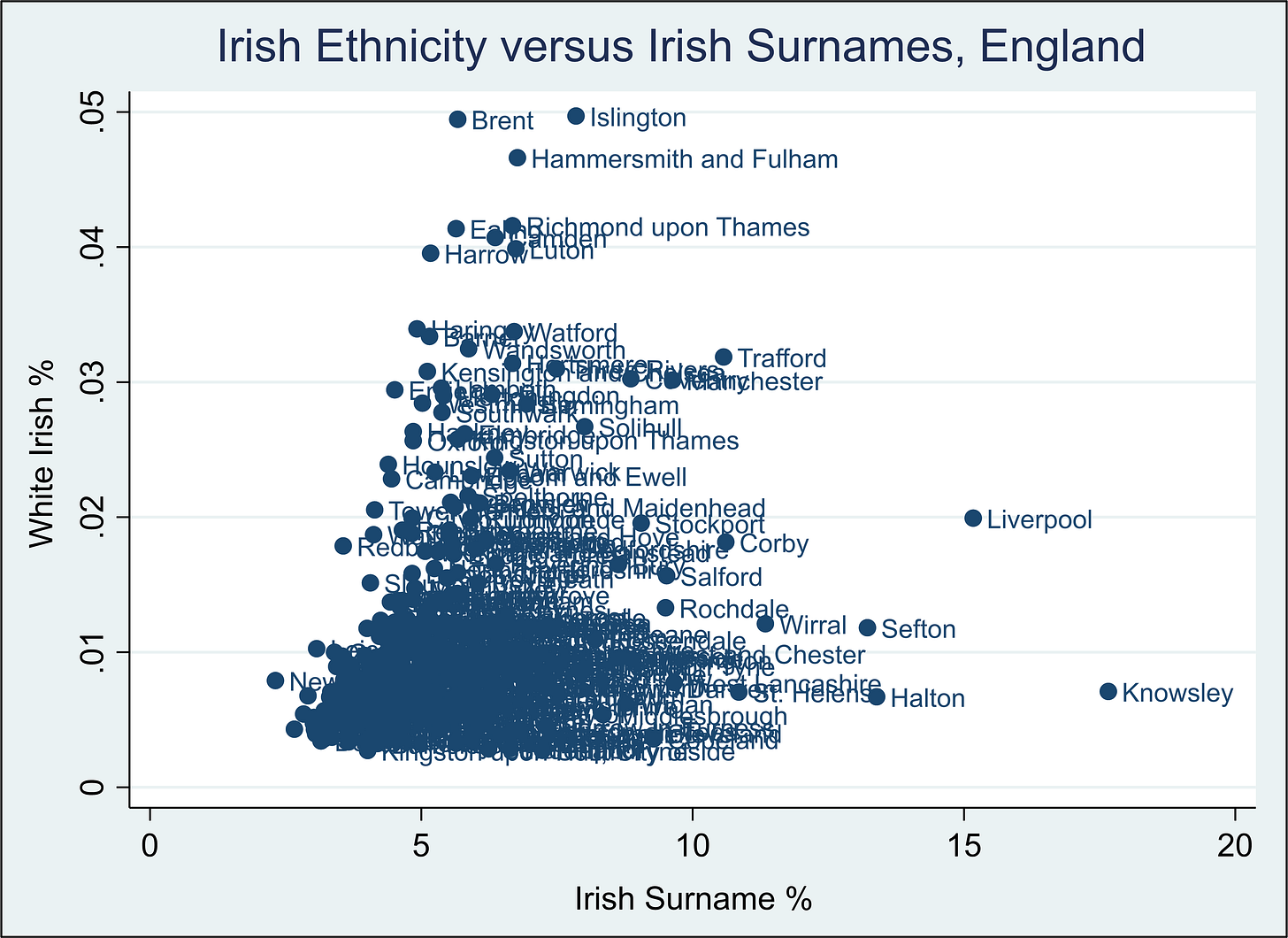
Many British Jews also identify as white British on the census and so do many offspring of mixed white British-European origin. Boris Johnson, David Cameron and Peter Mandelson are examples. In other cases, such as the Jewish Nigel Lawson and Michael Howard, surnames have been anglicised over time.
What we have here are individuals who objectively possess the markers of ethnic Englishness, but may subjectively identify with different lineages in their personal genealogy. This tells us that part of whether someone is ethnically English is that they ‘pass’ by possessing the main external markers of this ethnicity – English-sounding surname and accent, white racial appearance. Those who pass as such and identify with their English descent are properly classified as ethnically English, those who do not identify with their English origins belong to a different ethnic group.
We know that when people have options in their ancestry, the exotic background is often chosen rather than majority ethnicity because in a liberal culture that values diversity that is viewed as more distinctive. Hence Mary Waters found that white Americans with Italian heritage were more likely to identify as Italian than their other parts, while those of Scottish background identified with their non-Scottish origins. This represents a change from the pre-1960s period when those of part ‘old American’ background were more likely to identify with the WASP majority.
Politics increasingly matters for ethnic choice, with Brexit supporters undoubtedly more likely to identify as English than Remain voters with the same background – as the Islington example above illustrates. In the US, those of white-Hispanic ‘Spanglo’ ancestry are more likely to identify as white if they are Republican, Hispanic if Democratic. In the 19th century, Whigs identified with the plebeian Anglo-Saxons, Tories with the Norman heritage of the imperial line.
This begs the question of how mixed-race English individuals such as Calvin Robinson, Sunder Katwala, Ben Habib or Matthew Syed identify. I haven’t asked them, but surveys tell us that 35% of people with a mixed-race background in England identify as White British on the census. I’d wager that, in their hearts, at least one of the Right-leaning Habib, Robinson and Syed see themselves as ethnically English. Partly this depends on whether others accept them as such. How others categorise you affects how you see yourself, but there is still wiggle room based on what you find appealing.
At one time in the US, a ‘one-drop‘ rule operated in which even miniscule black heritage (but not Amerindian background) disqualified a person from being considered white. Having said this, plenty of light-skinned blacks passed as socially white. Today, white-Asian offspring are more likely to identify as white than white-black offspring in part because black identity in the US has always spanned a wide racial spectrum and this seems to affect the way Americans categorise people with some visible African origin.
It is not clear that the same holds in Britain, where black-white intermarriage is very common and light-skinned individuals with black ancestors such as UKIP MEP Steven Woolfe or football player Kieran Trippier would generally be considered part of the ethnic majority regardless of how they personally identify.
The blurring of race at the edges through intermarriage will matter a lot in the future, and it interests people like me who are of mixed background. But at present it is rare: 97% of people in England are of single racial origin. For them, categorisation is pretty straightforward.
Bottom line: Sunak is English by nationality, but not by ethnicity.
Eric Kaufmann is Professor of Politics at the University of Buckingham and Director of the Centre for Heterodox Social Science. He specialises in nationalism, the cultural Left and political demography. Subscribe to his Substack page, where this article first appeared.
Stop Press: Suella Braverman, the former Conservative Home Secretary, explains in the Telegraph why she “will never be truly English“. “I don’t feel English because I have no generational ties to English soil, no ancestral stories tied to the towns or villages of this land. My heritage, with its rich cultural and racial identity, is something distinct. I am British Asian, and I feel a deep love, gratitude and loyalty to this country. But I cannot claim to be English, nor should I. This is not exclusionary – it is honest. And it’s what living in a multi-ethnic society entails.”
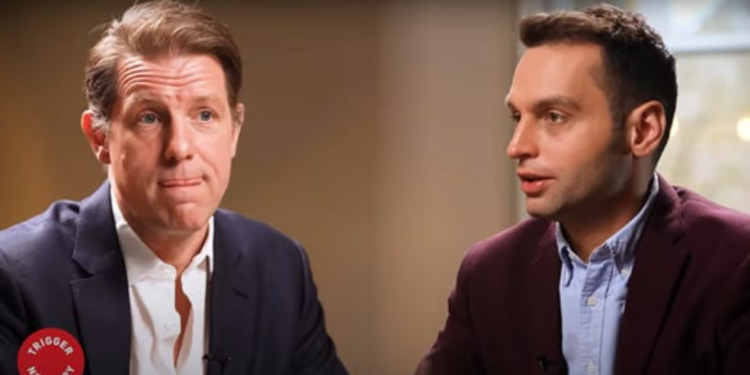
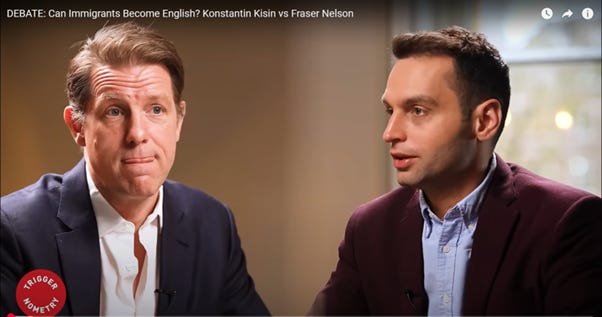
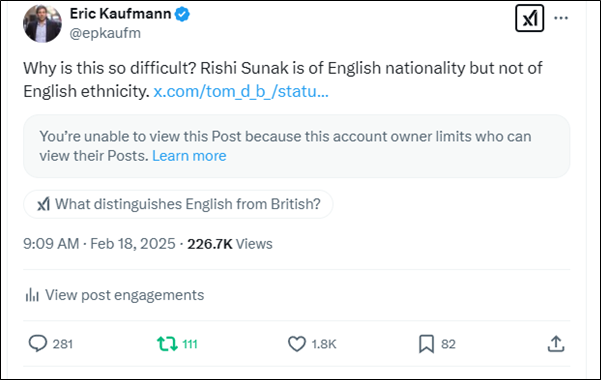
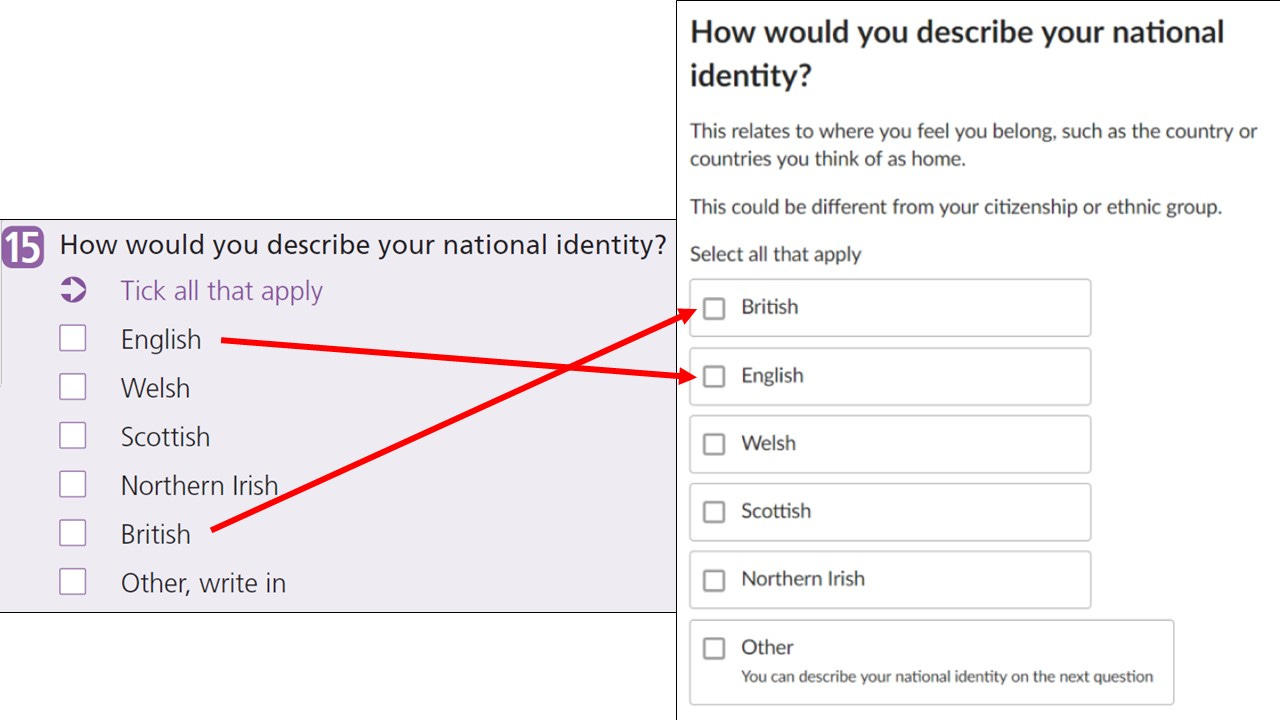












To join in with the discussion please make a donation to The Daily Sceptic.
Profanity and abuse will be removed and may lead to a permanent ban.
Strategy Directorate
Mayor’s Office for Policing And Crime | Email enquiries@mopac.london.gov.uk | Website: https://www.london.gov.uk/what-we-do/mayors-office-policing-and-crime-mopac | Address City Hall ,The Queens Walk, London SE1 2AA
Dear Mayor’s office for Policing.
1. The Government Ministers are misleading the public, into believing that the number of cases of Covid 19 confirmed each day on TV are the number of patients who have been diagnosed with symptoms of Covid 19 like disease , such as viral pneumonia. Let’s hope it’s a huge Fraud by Gates and only people who were going to die, had testing 28 days before so could be counted as Covid-19 deaths, to perpetuate the Fraud by failing to disclose information causing the public a loss of income and lively hood.
Please alert all those involved in referring to the number of “Cases,” reported to the authorities each day, should be defined as suspected cases, if they meet the criteria as set out in attaches, by the WHO.
If they have not been diagnosed, they must stop claiming they are CASES.
If they are found to test positive in response, after using a PCR test, it can’t be claimed that they are a
1. Case of Covid 19 disease,
2. Suspected Cases ,
3. A probable case of SARS – cob – 2 infection or
4. A confirmed case.
This is Fraud by failing to disclose information. They are not cases by positive response to a test not designed to find infectiousness.
A person is guilty of fraud by failing to disclose information if he: failed to disclose information to another person, when he was under a legal duty to disclose that information, dishonestly intending, by that failure, to make a gain or cause a loss.
https://www.cps.gov.uk/legal-guidance/fraud-act-2006
If a person is lead to believe they are infectious due to a positive PCR test and gives up working for 2 weeks to self isolate, not to infect the population, and he has made a loss due to the failure to disclose if he is a case or not by a doctor’s diagnosis, they have suffered from the crime of Fraud by failing to disclose information.
Please alert the secretary of state, the senior police, and the Public Prosecution service.
As there is no follow up, after testing positive, by a qualified doctor, to see what symptoms the person has, to declare they are a one of a number of types of cases, then the person has suffered Fraud by failing to disclose information.
This crime against humanity is taking place thousands of times a day still here and around the world.
By forcing people who have been living with a person who has tested positive, to be tested too, they have breached the
Old news – we’ve known about this phenomenon for months.
Real shame that TY has gone and taken the global censorship pill by murdering the comments section here.
As it has been said countless times; wearing masks wherever is a badge of submission; nothing more and nothing less.
“the more accurate polymerase chain reaction (PCR) lab test”
A year on, and the MSM is still promoting simplistic garbage like this – even when apparently on the side of the angels.